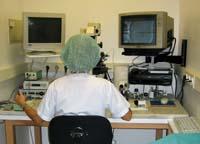When the solution is to choose the sex of the child

The technique of choosing the sex of the child has come from fertilization in in vitro. In vitro fertilization was developed in the late 1970s. This allowed for embryo in the hands before pregnancy. Therefore, they began the development of genetic disease research techniques or chromosomal abnormalities to obtain a reliable diagnosis before pregnancy and to be able to choose healthy embryos before the mother receives the embryo.
For the choice of embryos that do not have a certain genetic disease before pregnancy, they developed a genetic diagnosis. This technique was designed, among other things, to avoid diseases that are inherited with sex. Thus, in 1990, two twin sisters from London were born after the application of this technique. Since then the technique has become a common practice in many clinics and hospitals. And the law has had to regulate.
It allows selecting the sex of the embryo only when there is a risk of transmission of a serious disease.
Chromosome lottery

Many diseases are inherited in relation to sex. The vast majority are associated with the X chromosome (more than one hundred). They are rare diseases and are usually severe. These diseases include hemophilia and Duchenne muscular dystrophy, for example. These two diseases are the best known, but they are many more.
Usually these are recessive diseases, being the man who suffers the disease. The woman is only a carrier, that is, she does not develop, but she can give it to her son. The key is in sexual chromosomes.
The woman has two X chromosomes in the genome (she has the pair of XX sex chromosomes), and if one of them has a disease-causing gene, the other compensates, so to speak. That is, it substitutes the defective gene for another chromosome, so the woman does not develop the disease. When a woman reproduces, however, the baby who is going to be born will receive the X chromosome from her mother: the egg that the baby will produce will have one of those two X chromosomes, and may be the one with the disease gene or another.
If the child is a child, no problem. At most, it will carry the disease (like the mother), unless the father has the same disease. In general, the girl has a 50% chance of carrying the disease and not being the same. However, it will not develop the disease.
But if the child is a child, the thing is very different. It has a single X chromosome in the genome (it has a pair of XY sex chromosomes) and if this chromosome has a gene that produces some disease, the Y chromosome has no substitute for that gene and will necessarily develop the disease. The child of a woman with the disease has a 50% risk.

Therefore, a woman with an X-related disease is at risk for a child with 25% disease.
Today, people who have or are carriers of an X-related disease usually know it. They are aware that if they naturally stay, they may have children who develop the disease, but they are also informed of the possibility of using assisted fertilization and choosing the sex of the child before pregnancy.
Genetic diagnosis of the embryo, essential
The truth is that there are several methods to choose the sex of the child. For example, a selection of sperm can be made. This method is only used in the United States, with a success of 80-90%, so it is not entirely reliable. Currently, the only reliable technique for selecting a child's sex is preimplantation genetic diagnosis.
Suppose a woman carrying an X-related disease wants to be a mother, but does not want her children to develop the disease. Then you have to make sure you will have a daughter. And to do this, an in vitro fertilization must be performed unintentionally, that is, fertilize the oculum outside the uterus in the laboratory. The embryo thus created is the subject of a genetic diagnosis to know if it is a child or boy.

To make the most of the process we work with several embryos. Amaia is given hormone treatment so that the ovary gives as many eggs as possible. The eggs are extracted and fertilized with the sperm of the stepfather (or donor) obtaining embryos. Embryos grow. And about three days later, when each embryo has between six and eight cells, a biopsy is done: one or two cells are taken for analysis. Meanwhile, the embryo continues to grow.
The cell taken for analysis will indicate the sex of the embryo. This is done using a technique called FISH, fluorescent hybridization in situ. This technique uses fluorescent markers of different colors. Each marker is associated with a specific part of the chromosomes. Using a fluorescence microscope, markers are characterized. And depending on the color of the marker, chromosomes are distinguished, including sexual chromosomes. So under the microscope is known the sex of the embryo: if the same color appears in two, there are two X chromosomes, and therefore it is a girl; if different colors appear, it has X and Y chromosomes, that is, it is a boy.
Embryos with two X chromosomes are selected, of which a maximum of three (where the law sets the limit) are placed in the mother's uterus. If any of the embryos are attached, the woman becomes pregnant. The goal has been met: she has a daughter in the womb, a daughter who will not develop the disease.
Embryo in good hands
Mari Jose Iñarra is an expert in assisted fertilization who states that the success or failure of this process depends on several factors. For example, the skill of the expert doing the laboratory work has a great influence. This is a very fine job: the choice of the most suitable eggs and sperm for fertilization requires a sharp eye and competent hands to work with such fragile material.

Moreover, maternal age also plays an important role in in in vitro fertilization. In fact, the quality of the egg in juveniles is usually better in general. And the quality of the embryo depends more on the egg than on the sperm.
However, in this case, that is, when in vitro fertilization is performed to select sex, the age of parents is usually not especially high. A priori do not have problems getting pregnant, they want to avoid the risk they would have with natural pregnancy and genetic diagnosis allows them.





